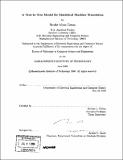A tree-to-tree model for statistical machine translation
Author(s)
Cowan, Brooke A. (Brooke Alissa), 1972-
DownloadFull printable version (17.47Mb)
Other Contributors
Massachusetts Institute of Technology. Dept. of Electrical Engineering and Computer Science.
Advisor
Michael J. Collins.
Terms of use
Metadata
Show full item recordAbstract
In this thesis, we take a statistical tree-to-tree approach to solving the problem of machine translation (MT). In a statistical tree-to-tree approach, first the source-language input is parsed into a syntactic tree structure; then the source-language tree is mapped to a target-language tree. This kind of approach has several advantages. For one, parsing the input generates valuable information about its meaning. In addition, the mapping from a source-language tree to a target-language tree offers a mechanism for preserving the meaning of the input. Finally, producing a target-language tree helps to ensure the grammaticality of the output. A main focus of this thesis is to develop a statistical tree-to-tree mapping algorithm. Our solution involves a novel representation called an aligned extended projection, or AEP. The AEP, inspired by ideas in linguistic theory related to tree-adjoining grammars, is a parse-tree like structure that models clause-level phenomena such as verbal argument structure and lexical word-order. The AEP also contains alignment information that links the source-language input to the target-language output. Instead of learning a mapping from a source-language tree to a target-language tree, the AEP-based approach learns a mapping from a source-language tree to a target-language AEP. The AEP is a complex structure, and learning a mapping from parse trees to AEPs presents a challenging machine learning problem. In this thesis, we use a linear structured prediction model to solve this learning problem. A human evaluation of the AEP-based translation approach in a German-to-English task shows significant improvements in the grammaticality of translations. This thesis also presents a statistical parser for Spanish that could be used as part of a Spanish/English translation system.
Description
Thesis (Ph. D.)--Massachusetts Institute of Technology, Dept. of Electrical Engineering and Computer Science, 2008. Includes bibliographical references (p. 227-234).
Date issued
2008Department
Massachusetts Institute of Technology. Department of Electrical Engineering and Computer SciencePublisher
Massachusetts Institute of Technology
Keywords
Electrical Engineering and Computer Science.